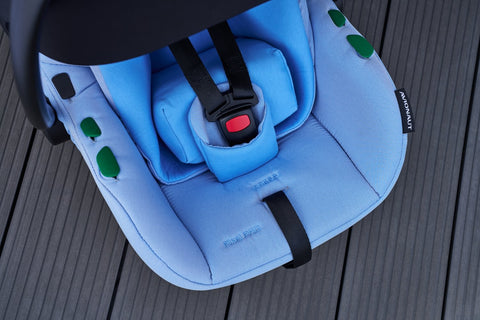Buckle crunch occurs on a seat installed with the vehicle seat belt.
Car seats are designed to be installed using the seat belt webbing – not the buckle. When the child car seat is held in place while in contact with the buckle, it can cause problems. As explained.
In some cars, the buckle stalks are quite long and this can result in the buckle being pulled across the plastic or metal structure of the car seat. This is known as buckle crunch; buckles should only be pulled in a straight line and not bent over the frame of the car seat otherwise it can cause the buckle to shatter in a crash.
If you try a seat in your car and the buckle is too high, you can try a different position in the car, or you may need to choose a different car seat altogether.
Why is buckle crunch a problem?
Buckle crunch can be dangerous as it prevents the proper functioning of the car seat.
The plastic casing of the seat belt buckle can get bent over the plastic of the child seat. This applies a lot of pressure on the plastic casing, especially in the event of an accident. The plastic casing will likely snap and the car seat can come loose.
How do you prevent buckle crunch?
Thankfully, it’s easily avoided, so long as you know what it is and to look out for it. Essentially, you just have to install the car seat correctly using the belt, not the buckle.
However, it demonstrates why it’s so important to get the right car seat for the car, because shapes and sizes vary, leading to buckle crunch. It’s why you should test a seat out in your car before buying it.
At In Car Safety Centre, we always test for buckle crunch and any car seats installed by the In Car Safety Centre will be positioned correctly.
What if you have buckle crunch?
Don’t panic.
If you’ve discovered that you do have a buckle crunch issue, experiment with the positioning of your car seat. Usually, moving the seat into a different position will solve the problem.
Some seats also have alternative seat belt routing, so see if there are signs that you can belt up the seat in a different way.
However, if your seat is indeed incompatible with your car, we highly recommend replacing it. Bring it into the In Car Safety Centre first, to see if we can help with repositioning it, or we’ll recommend you an alternative.
Do not hesitate to get in touch with a member of our team if you have any more questions.
Book a consultation with one of our expert car seat specialists today.







Comments (0)
There are no comments for this article. Be the first one to leave a message!